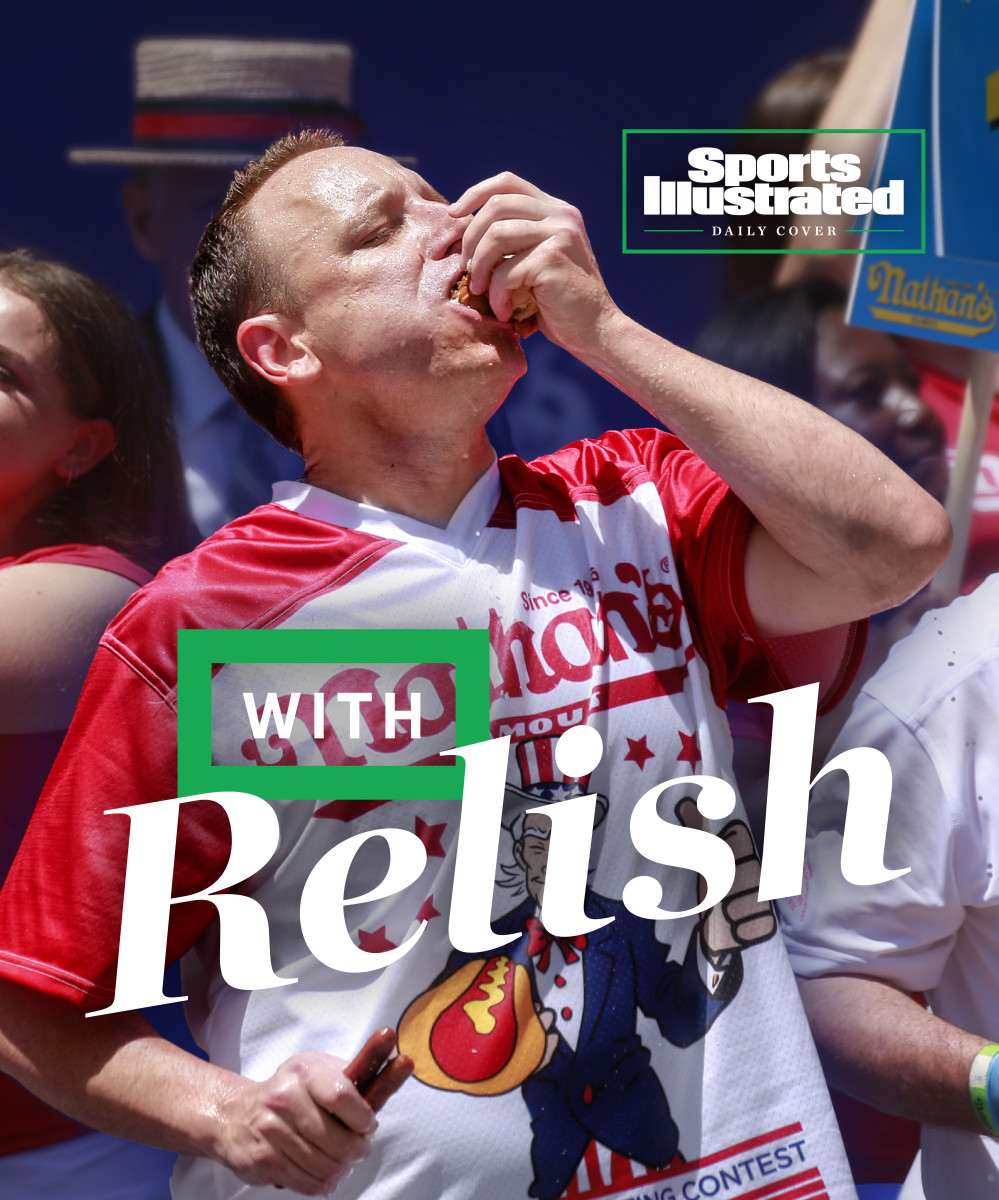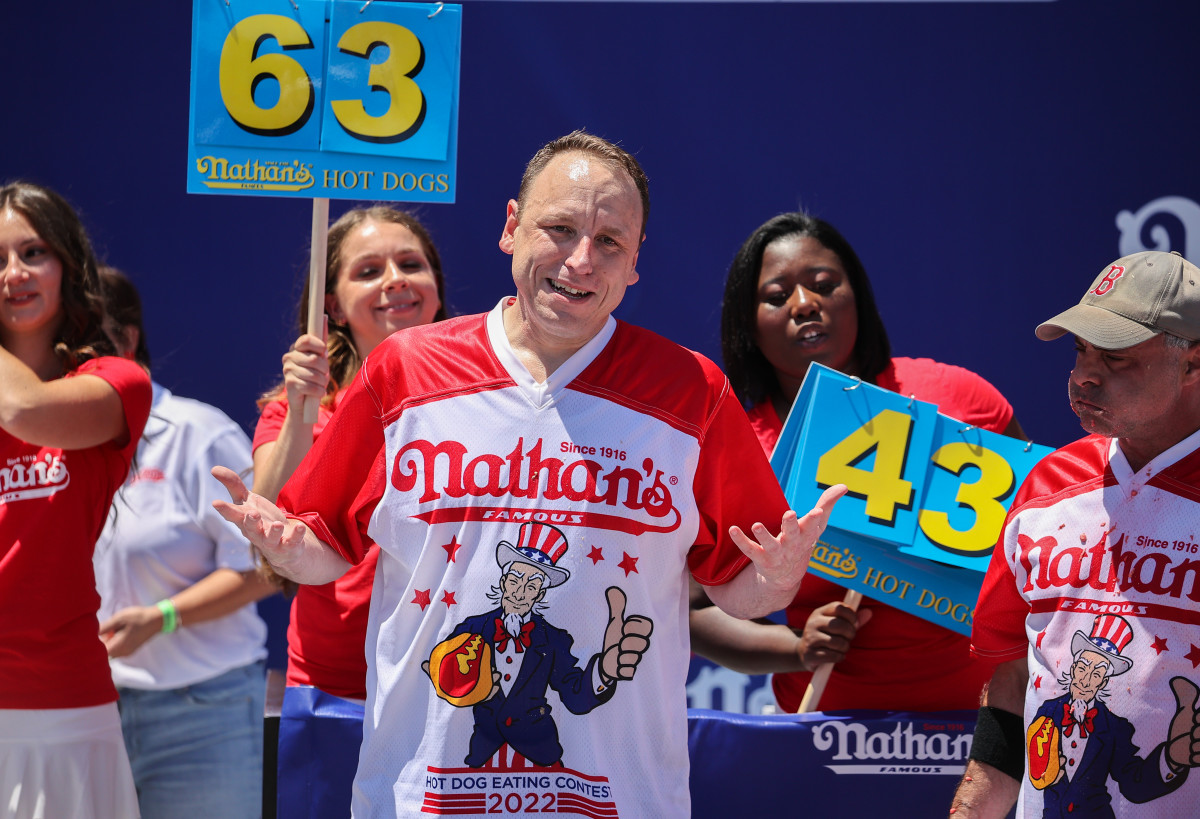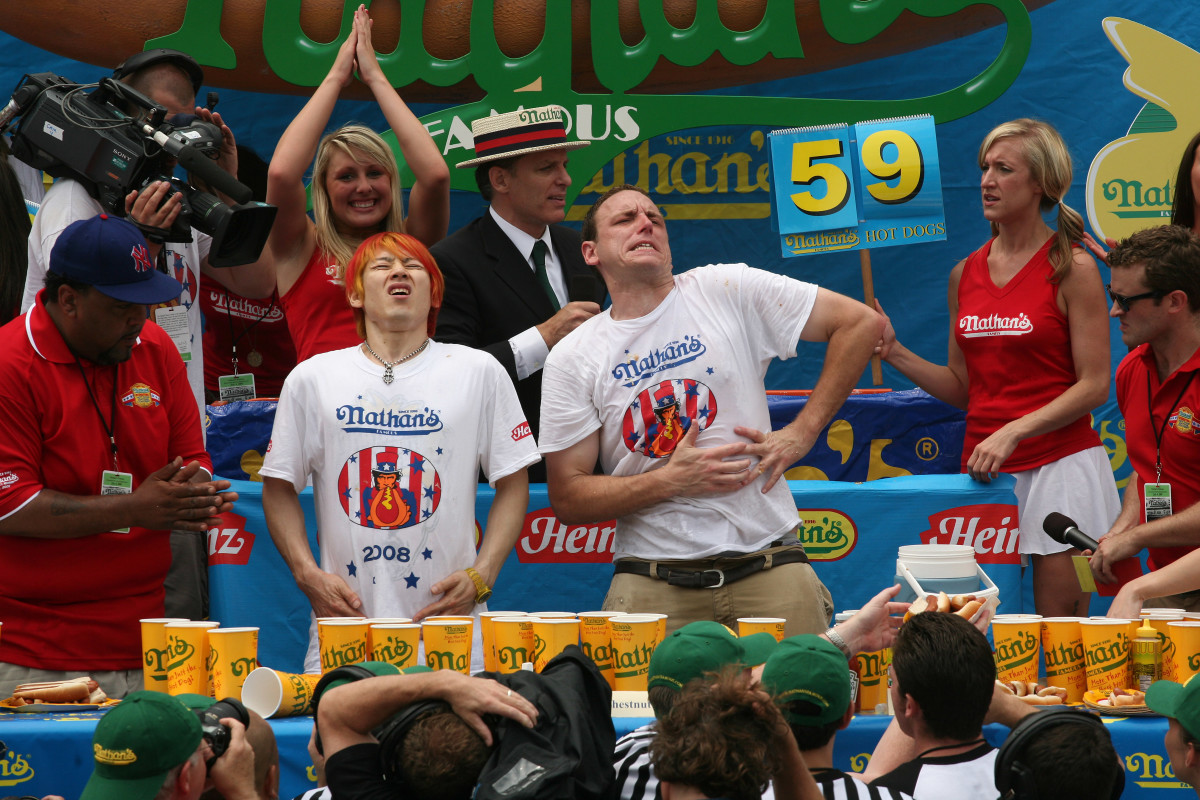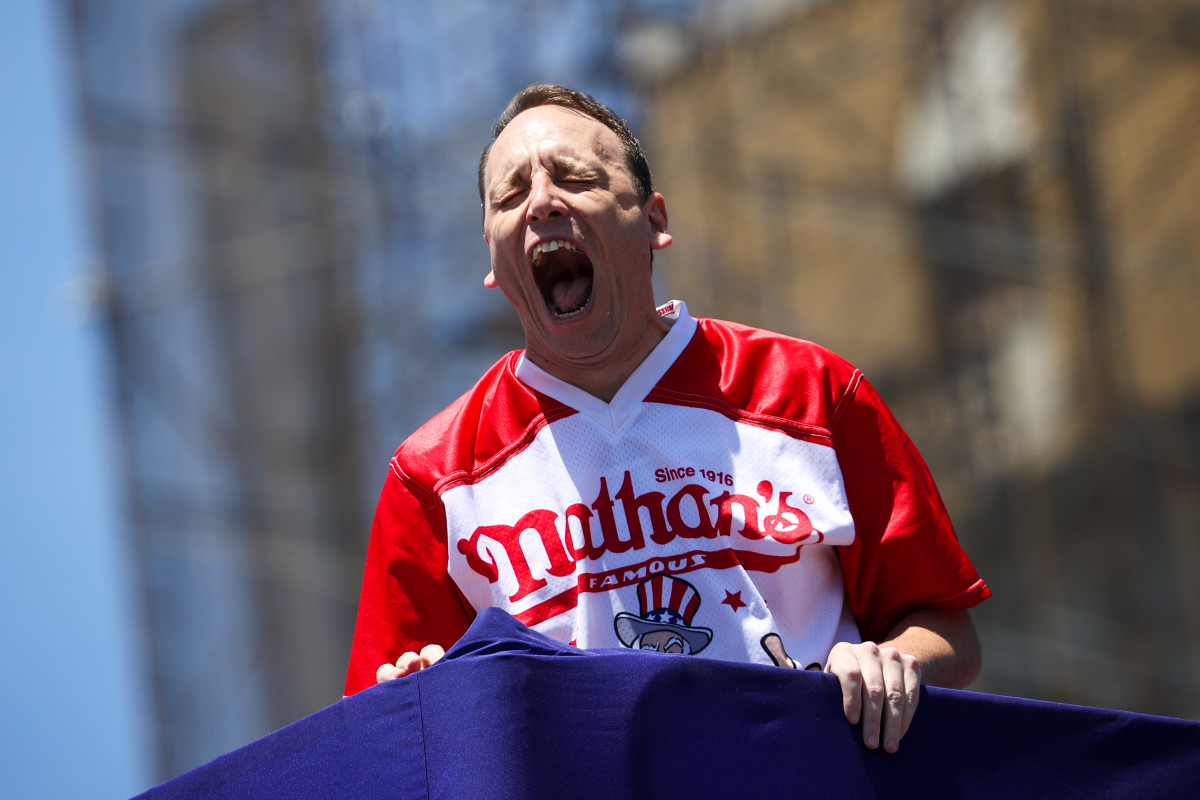What Joey Chestnut Wants

Joey Chestnut has nothing left to prove in the world of competitive eating.
Over the last decade and a half, Chestnut has traveled the world, cemented a legacy, eaten his way to records in foods including pepperoni rolls, hard-boiled eggs, mutton sandwiches, poutine, tamales, gyros, burritos (long form), ramen noodles (short form) and, of course, hot dogs. He is the most decorated eater in history. That includes an unprecedented 15 titles in the premier competition in the sport: Nathan’s Famous International Hot Dog Eating Contest at Coney Island on July Fourth. He’s the rare eater to make a full-time career of the craft. Until collecting his fourth hot dog title, Chestnut had a day job in construction management, but since 2011, he’s been able to simply eat.

Yet when he is asked whether he has done what he wanted—whether eating has given him what he expected—Chestnut talks about none of that.
“I had a really crappy GPA in college,” says Chestnut, who majored in engineering at San José State, “and so I took this easy class to boost it.”
The class was about the philosophy of a meaningful life. Easy A, he figured. But the material stuck with him. It covered “intrinsic value, the things that make you happy and why they make you happy, need versus want,” Chestnut says. As a 22-year-old student, he thought he had a decent handle on what that would mean for him. A meaningful life would entail the standard fare—family and friends and so on—plus a few specific professional ambitions. “My goal was just to be the champion,” says Chestnut, who’d started eating competitively earlier in college. “And then my next goal was to run a small contracting business.” Now, of course, those goals sound almost charmingly modest.
What Chestnut wants has expanded—like a stomach prepped for competition—as his understanding of a meaningful life has grown more nuanced.
He has redefined possibility at the hot dog table. When he began eating, 50 was considered a hallowed, almost untouchable benchmark when it came to hot dogs and buns; Chestnut’s current record in competition is 76 in 10 minutes. He is at a point where many athletes start to contemplate retirement—a few months away from turning 40—if they haven’t already been forced into it. But there is no documented aging curve for a competitive eater at this level. Chestnut is the only one to do what he does quite like he does it. And he believes he still has more to eat.
To some, his profession is a punch line, an absurd tribute to excess. To Chestnut, it is art, science and obsession alike. His appetite for competition is (appropriately) endless. And when all is swallowed and digested, he hopes, it will feel like the foundation of a meaningful life.

About once a week, through spring and early summer, Chestnut goes down to his basement in Westfield, Ind., and eats dozens and dozens and dozens of hot dogs in 10 minutes, the standard length of a competition.
The actual eating is just one piece of his training. He does a liquid cleanse before his big eat. He does a full day of stretching and breathing exercises. “There’s a whole ordeal that goes into every practice,” Chestnut says. “And then after every practice, it’s feeling like garbage for a couple of days.” At his first one in the spring, he will usually eat a little more than 50 hot dogs. By June, he will have worked his way up to consistently hitting the high 70s or low 80s.
“He leaves no stone unturned,” says fellow competitive eater Miki Sudo, who holds the women’s hot dog record at 48.5 dogs and buns. “He’ll really try to control everything that he can in terms of the physical side and the mental side.”
Chestnut has spent years searching for the best exercises to hone his eating muscles. He chews on a specially made ball to strengthen his jaw. He puts on a gum guard attached to a bag full of weights and lifts them with his teeth. He experiments with different ways of swallowing while moving his head. He stretches his stomach by chugging water. He practices breathing, making sure he can inhale between swallows or bites rather than leaving himself gulping for air when it’s too late. He devotes time to learning how to move past any potential burps. (“If you’re eating fast, you’re taking in air, and if you take in air, you’re going to have to burp, and if you’re burping, food comes out, and it looks like barf,” he says. “You don’t want to barf.”) Chestnut has figured all of this out himself—an engineering problem, he says, like he studied in college. He’s revolutionized competitive eating in the process.
“That’s what people do in sports,” says Tim “Eater X” Janus, once a fierce competitor of Chestnut’s, now retired from eating and a close friend. “They go out there, and they dream, and they try new things. That really helps people to become pioneers. So he’s been one of those. I think he’s done more to change the way people train than anybody.”
But the centerpiece of all this work is still the big weekly eat. He used to be able to do these more often—every three or four days instead of every six or seven. “When I was younger, I was an animal,” Chestnut says. “I could gain weight fast and lose it just as fast.” If he’d known then what he knows now, he thinks, there is no telling what records he may have set: Just imagine if he’d figured out these techniques at 26 or 27. But, of course, he couldn’t have. The knowledge that directs his training came only with time. And he thinks he’s currently in an ideal spot. If his work is harder on his body now, Chestnut feels so much better equipped to handle it that he thinks this is his prime, or very close to it.
His fiancé, Brie, often helps him prepare the practice hot dogs. (“It’s hard to cook 70 or 80 hot dogs at a time,” he says.) The pair first met at a bar in San Francisco, a brief encounter immediately after Chestnut was eliminated from The Amazing Race in 2017, and she posed for a quick picture with the eating icon. A year later, they came across each other on Tinder, and, after swiping right, she asked whether he remembered taking that picture with a stranger in a bar months ago. He did, “and we went on a date, and it was perfect,” Chestnut says.
They moved from California to Indiana a few years ago. Chestnut had long made an annual winter trip to Indianapolis for its shrimp cocktail eating contest. (His best is 18 pounds and 9.6 ounces in eight minutes, tails pre-removed.) He’d always liked the area. But he made a summer visit for an ice cream eating contest and liked it even more. This could work, Chestnut thought. The next time he came, he looked at houses, and they now have a place with a big garden and space for their dogs.
And the concrete basement, which is home to his training equipment, a Peloton bike, a weight bench and the table on which he eats scores of hot dogs weekly.
“I set up all the hot dogs,” Chestnut says, “and have some music blaring and go to town.”
All this has made Chestnut unquestionably the best hot dog eater in the world. And there was perhaps no better display of that than what he did at Coney Island in 2022.
It was “a terrible year,” Chestnut says, both personally and professionally. He ruptured his right Achilles tendon and had to come to the hot dog contest in a walking boot. The injury kept him from his usual cardio routine—contrary to old stereotypes of burly, big-bellied eaters, this line of work requires significant attention to fitness—and he wasn’t at his best physically. He wasn’t any better off emotionally. Chestnut’s mother died last June, and, on July Fourth, he was still reeling. And he didn’t get any favors from circumstance, either. Protesters breached the stage in a demonstration against pork production, and, while security was quick to corral them, one still had time to approach Chestnut, who fixed the protester in a headlock before continuing on with his eating, the clock running all the while.
The rest of the eating world had borne witness to his commitment and competitive drive for years. But this felt like another level.
“It’s just him, his mind and his stomach,” says Crazy Legs Conti, a veteran competitive eater. “Nothing seems to break his concentration.”
His concentration held. Still: It was a rough contest all the same.
The result was Chestnut’s worst finish in seven years—63 hot dogs and buns. (He’d set his record the previous year at 76.) By his standards, it was a terrible showing. It would have been a natural moment for a competitor to knock him off. But that would have required a serious hot dog challenger to exist. And this is how profoundly he owns July Fourth: A grieving, injured Chestnut interrupted by protesters is still more capable than all the best eaters in the world. No one else ate more than 48 hot dogs.
“He’s so far ahead of everybody,” says Geoff Esper, who came in second place. “It’s tough to think that you’re actually going to beat him even if he has a bad day. It’s still so much of a gap.”
Which comes with a natural question: When a competitor is this much better than everyone else, seemingly no one to drive him forward, why keep going?
There’s one answer that feels obvious: Anyone driven enough to eat 80 hot dogs alone in his basement, week after week, no one watching, is competitive enough to push himself toward greatness without any external pressure. (“You’ve got to have that drive, that fire, that intensity,” says Sudo. “You almost have to be borderline insane to want to chase something like a hot dog record.”) If Chestnut thinks he can break his own record—again—he doesn’t want to stop before he has to. But there’s another answer, too. He loves it. Chestnut is known as a rhythm eater—two hot dogs, two buns, two hot dogs, two buns—and when he is really working, when he has found just the right groove, he does not have to think at all. He’s dedicated his adult life to hot dog eating as an engineering problem. In those moments, he has solved it.

It wasn’t always like this. The early years of Chestnut’s eating career were defined not by this kind of untouched dominance, but by fierce, motivated rivalry.
Chestnut stumbled upon competitive eating when he was 21. He found he was a natural: a guy who had always liked food, one of six kids, used to eating fast to beat his brothers for seconds when they were growing up. It was one of those brothers who saw a lobster-eating contest at a casino in 2005 and suggested Chestnut enter. He did—mostly because it was the only way to get unlimited lobster as a broke college kid. But he quickly realized his talent and, more than that, he felt a competitive spark. Chestnut wanted to beat the best. He wanted to be the best.
He wanted to take down Takeru Kobayashi.
This was supposed to be unthinkable. Kobayashi had professionalized competitive eating, and he was the first to garner mainstream attention for the sport, appearing on television shows and making headlines for his performances. “He was eating twice the field,” Conti says. “Eaters were just slack-jawed.” Kobayashi had first competed in his native Japan, and, when he debuted at the hot dog contest on July Fourth in 2001, he nearly doubled the previous record in becoming the first person to eat 50. He treated competitive eating like a craft—technical, precise, something to be mastered and refined. No one realized he could be beat.
“I didn’t think it was possible,” Janus says. “I don’t think any of the guys who had lost to Kobayashi before thought it was possible. And for some reason, Joey did, and he was right.”
It took a few years. In Chestnut’s first time at Coney Island—just a few months after that first lobster contest—he came in third with 32 hot dogs to Kobayashi’s 49. The next year, he came much closer, with 52 hot dogs to Kobayashi’s 53.75. (Yes, the contest employs that kind of precision.) And with his third attempt, finally, he did it. Chestnut 66, Kobayashi 63.
“It still kind of doesn’t seem real,” says competitive eater Patrick Bertoletti. “People forget how dominant Kobayashi was for so long.”
But Kobayashi had six titles, so naturally, Chestnut wanted at least seven.
“There was a relief I sensed from him that he had finally done it, that he had finally won,” Conti says. “But I think right away, he said, This isn’t all I want to be. … Hungry for more isn’t just a cliché.”
Chestnut beat Kobayashi a second time in 2008 and a third time in ’09. That would be the last time Kobayashi ate at Coney Island: After a messy contract dispute with Major League Eating, and an even messier fallout, he left the contest behind for good. But with three consecutive victories, Chestnut had already been anointed the king.
He was the right eater in the right place at the right time. That was partially his natural talent. (“His capacity’s bigger,” Esper says of Chestnut’s stomach. “He might even have the biggest capacity out of all eaters.”) It was partially his creativity in training. (“He’s a very curious person about himself and his body and his health,” Bertoletti says. “He’s always experimenting.”) It was partially his ambition. (“One of Joey’s greatest strengths was that he didn’t set limits for himself,” Janus says. “Or if he did, they were just way higher than what anybody else set.”) The result was an eater the world had never seen before.
Even his name seemed perfect.
“It sounds a bit like a Dickens character or something,” says Janus.
“It’s a good competitive-eating name, or a good porn star name,” says Bertoletti.
Without his chief rival to challenge him, Chestnut still kept cruising, winning year after year after year. He matched Kobayashi’s six titles and then surpassed them. But he was beginning to plateau—Chestnut kept topping out at 68 or 69 hot dogs, even though he felt confident he should be able to hit 70.
It took one final jolt of competition to get him there.
Chestnut did not have a good 2015. As July Fourth drew near, he was dealing with the end of a long-term relationship, and at the weigh-in for the contest, “he knew he was not ready,” Janus says. He was miserable. It came through in his eating. In a different year, perhaps, he could have gotten away with that. But not ’15. There was an ascendant talent at the table named Matt Stonie, who would burst through with 62 hot dogs, while Chestnut ate just 60.
After eight consecutive titles, Chestnut had lost.
The end of his streak was destabilizing. Chestnut took some rare time off. He did what anyone with the resources and time might do here: He went to Thailand, sat on the beaches of Koh Samui, drank mushroom smoothies and thought about his life. What was the point? Was this meaningful? What was he doing? And he decided he would make some changes. He was going to rededicate himself to the art of eating hot dogs. Chestnut was tired of topping out at 68 or 69. He wanted 70. There were people who said it was impossible, but people had said 65 was impossible, or 60, or 55, and look what he had done to those supposedly insurmountable numbers. He was going to get even better. And he was going to do whatever it took.
“It sucked, the whole thing, losing,” Chestnut says. “But I came back stronger in so many ways.”
He began experimenting with and refining his exercise and training routine. The next year, Chestnut became the first person to eat 70 hot dogs and buns at Coney Island. (Stonie finished second with 53.) The year after, Chestnut ate 72, then 74, then 75, then 76. Even when he slipped in the maelstrom of 2022, he still ate 63, more than the 62 that Stonie beat him with in ’15. Chestnut’s average margin of victory in the last seven years has been 19 hot dogs. If he seemed dominant before he lost—it’s nothing compared to what he’s done since.
The focus has made him somewhat more beatable in other foods. (A considerable part of his training is specific to hot dogs.) When it happens, he’s “a gracious loser,” Esper says, just as he is a winner. (“You’d think he’d probably be in your face, but he doesn’t do that.”) But on the Fourth of July, there is no question, because Chestnut owns the day.

On a Saturday in June, Chestnut is the guest of honor for the Bowling Green Hot Rods, a minor league baseball team in Kentucky. For one game, they have rebranded themselves as the Hot Dogs, and if you’re looking for someone to symbolize hot dogs—who else? Oscar Mayer has been dead for almost 80 years. Nathan Handwerker, namesake of the famous franks eaten on the Fourth, has been dead for almost 50. That leaves no one more closely associated with the hot dog than Chestnut.
He throws out the first pitch, gives a demo of eating famous regional foods, and judges a hot dog contest with local celebrities. (A sports radio host wins.) But the centerpiece is the meet-and-greet. Everyone wants a moment with Chestnut.
A woman comes through the line three separate times to make sure that she gets the perfect photograph with him. A young man gets on bended knee and pretends to propose with a foil-wrapped frank: “Will you accept this glizzy?” (Chestnut laughs and poses for a photo but passes on the hot dog. That’s not so weird, he says later: What’s weird is the people who ask him to split a dog, Lady and the Tramp style, taking bites from each end.) A young boy is so beside himself at the sight of Chestnut that his mother tries to translate: “He’s starstruck.” Only one person asks him to sign his wiener. (The wiener in question is a ceramic ornament; Chestnut dutifully autographs the bun.) A couple tells him their wedding anniversary is July 4, and every year, they celebrate by watching him eat. An older lady seems a bit apologetic to note she is a vegetarian when she says she loves his work. Chestnut grins and tells her that’s fine: His first eating victory was actually in asparagus in 2005. (It was his second contest, shortly after the lobster, and he now holds the world record in the discipline, with 12 pounds of deep-fried asparagus spears in 10 minutes in ’14.) The line of fans who want to meet him is steady from the time the gates open until the game is almost over.
For some, it’s a bit of a joke, or maybe entirely a joke. (After all: This is a minor league theme night.) For others, it’s pure, sincere admiration. But the foundation is the same. They all recognize that Chestnut is one of a kind.
“He’s got a great deal. I mean, he gets to travel around and eat hot dogs. He gets to take plenty of time off. He’s not showing up to an office and punching a clock. … I think he realizes he’s got something special, and why give it up before you’re truly ready?” says Janus, who retired in 2016, mostly because he was concerned about how his body was holding up. “I think that’s the thing. Make sure you’re ready before you quit.”

Chestnut isn’t. There’s the 80-hot-dog threshold—in the right rhythm, under the right conditions—if it’s not so hot that everyone is miserable and not so humid that the buns lose their shape—he believes he can pass it. There are other goals, too. “I’d like to do more overseas,” he says. “Go to different places, have awesome food from different countries.” That’s traditionally been difficult under Major League Eating’s contract system, but he says, at last, he has a little more freedom.
Chestnut knows this is a profoundly weird way to make a living. “It’s ridiculous,” he says. “It’s like the world’s on crazy pills.” But he doesn’t want to give it up. And there’s something else, too: No one asks an NFL player why he plays football, or a champion marathon runner why he needs to run so far, or a grandmaster why he keeps playing chess. Joey Chestnut eats. Mostly, he thinks, it’s a meaningful life.
